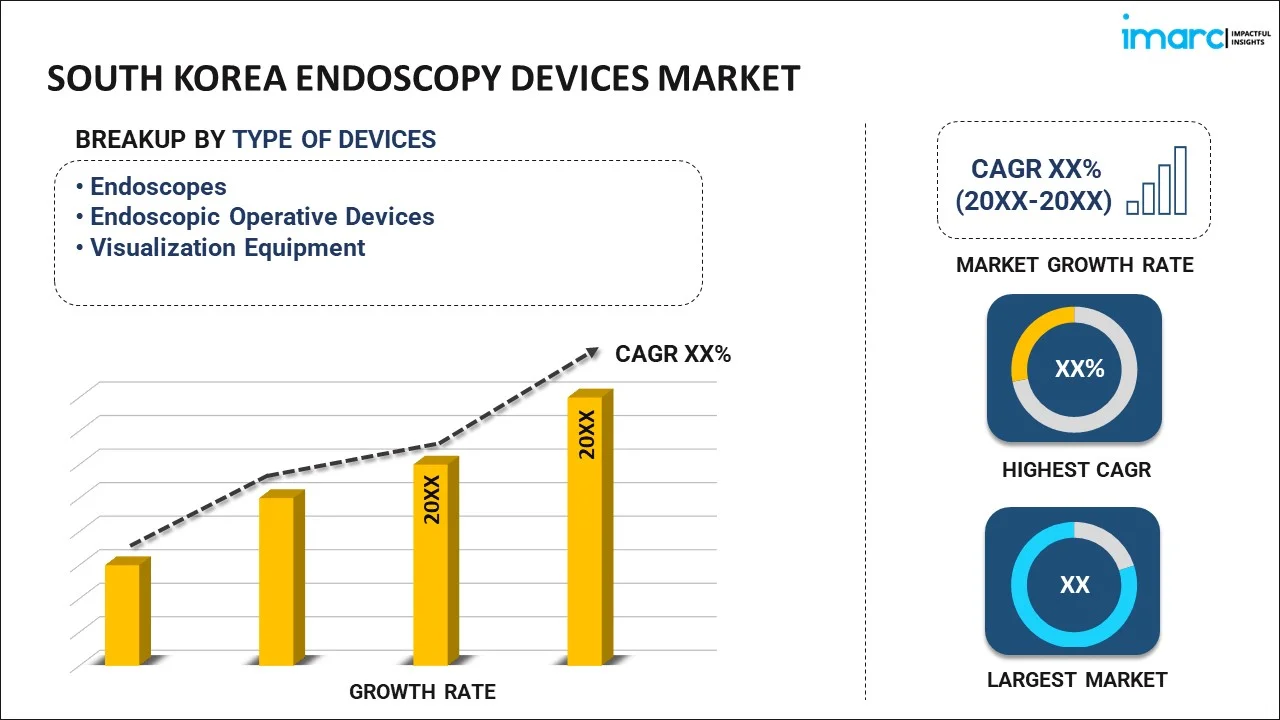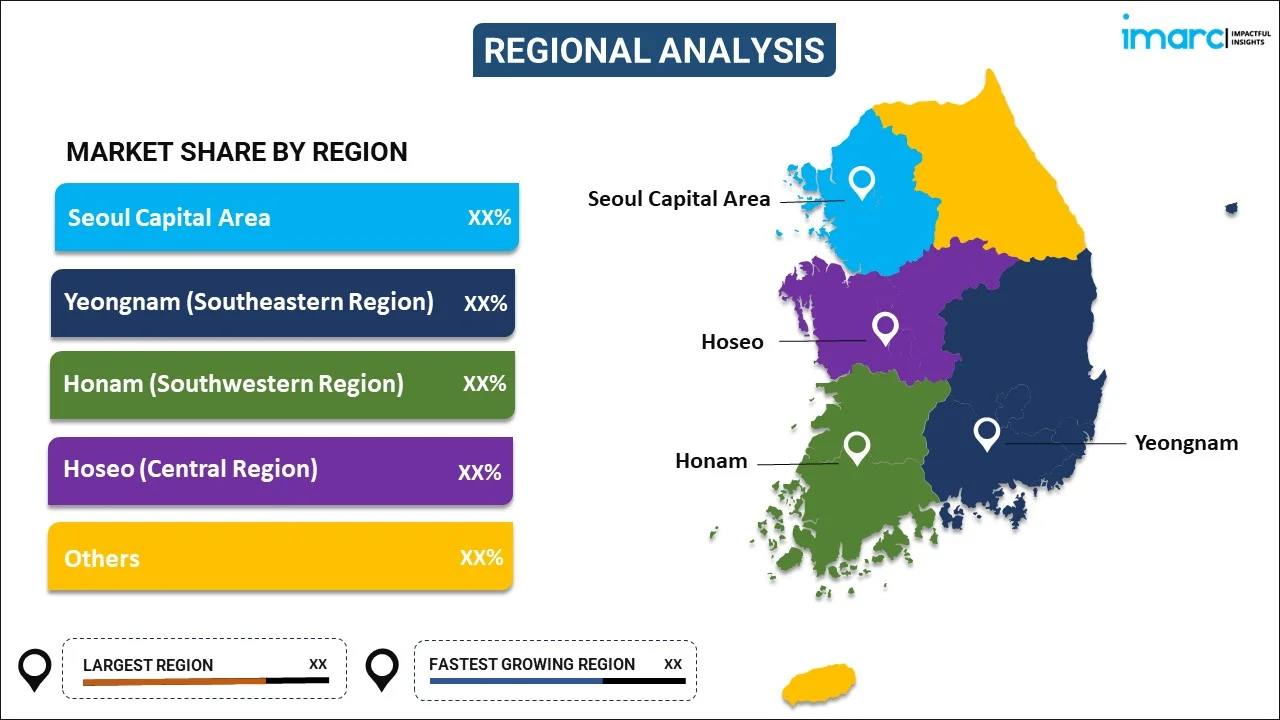
South Korea Endoscopy Devices Market Report by Type of Device (Endoscopes, Endoscopic Operative Devices, Visualization Equipment), Application (Gastroenterology, Orthopedic Surgery, Cardiology, Gynecology, Neurology, and Others), End Use (Hospitals and Clinics, Ambulatory Surgical Centers, and Others), and Region 2025-2033
Market Overview:
The South Korea endoscopy devices market size reached USD 1.2 Billion in 2024. Looking forward, IMARC Group expects the market to reach USD 1.6 Billion by 2033, exhibiting a growth rate (CAGR) of 3.2% during 2025-2033. The burgeoning healthcare infrastructure and rapid technological advancements in the country, the increasing prevalence of chronic conditions, the rising geriatric population prone to chronic conditions, and the implementation of various government incentives and funding initiatives represent some of the key factors driving the market.
|
Report Attribute
|
Key Statistics
|
|---|---|
|
Base Year
|
2024 |
|
Forecast Years
|
2025-2033
|
|
Historical Years
|
2019-2024
|
| Market Size in 2024 | USD 1.2 Billion |
| Market Forecast in 2033 | USD 1.6 Billion |
| Market Growth Rate (2025-2033) | 3.2% |
Endoscopy devices refer to specialized medical instruments designed to view the internal structures of the human body. They consist primarily of an elongated tube equipped with a light source and a camera at one end. Endoscopy devices are available in different types, such as gastroscopes, colonoscopes, bronchoscopes, and laparoscopes. They are manufactured from durable materials like stainless steel, high-grade plastic, and optical fiber technology for improved imaging. Endoscopy devices are utilized in gastrointestinal tract examinations, respiratory system assessments, urinary tract evaluations, arthroscopic procedures, obstetrics and gynecology inspections, and more. Additionally, they are crucial in laparoscopic surgeries, endoscopic retrograde cholangiopancreatography (ERCP), capsule endoscopies, and esophagogastroduodenoscopy (EGD). Endoscopy devices offer several advantages, such as minimally invasive entry, reduced patient discomfort, quicker recovery times, and high precision in diagnosis and treatment. They are also instrumental in performing biopsies, removing foreign objects, and facilitating complex surgical procedures. In addition, endoscopy devices are known for their lower risks of infection, reduced need for large incisions, shorter hospital stays, and less postoperative pain.
South Korea Endoscopy Devices Market Trends:
The increasingly improving healthcare infrastructure and rapid technological advancements in the country are major factors contributing to the market growth. Moreover, the rising prevalence of chronic conditions, such as gastrointestinal disorders, respiratory diseases, and urinary tract complications, necessitating the use of sophisticated diagnostic and treatment methods, is propelling the market growth. Besides this, the growing acceptance of minimally invasive surgeries (MIS) due to their shorter hospital stays, quicker recovery, and lower postoperative complications is providing a thrust to the market growth. Furthermore, the rising geriatric population prone to chronic conditions, thereby driving the need for diagnostic and therapeutic endoscopic procedures, is enhancing the market growth. In addition to this, the implementation of various government incentives and funding initiatives aimed at boosting healthcare technology are contributing to the proliferation of advanced endoscopic solutions. Along with this, the rising medical tourism sector in South Korea, owing to its high standards of medical services at competitive prices, is providing a considerable boost to the market growth. Additionally, the incorporation of artificial intelligence (AI) and telesurgery in endoscopy, making procedures precise and enabling remote operations, is bolstering the market growth. In confluence with this, the development of disposable endoscopes, which minimize cross-contamination risks, and the emergence of three-dimensional (3D) endoscopy offering enhanced depth perception and spatial orientation are providing a thrust to the market growth. In addition to this, the growing partnerships and collaborations between South Korean healthcare institutions and global medical technology companies, aiming to foster innovation and co-development of next-generation endoscopy devices, are providing lucrative growth opportunities for the market across the country.
South Korea Endoscopy Devices Market Segmentation:
IMARC Group provides an analysis of the key trends in each segment of the market, along with forecasts at the country level for 2025-2033. Our report has categorized the market based on type of device, application, and end use.
Type of Device Insights:

- Endoscopes
- Rigid Endoscope
- Flexible Endoscope
- Capsule Endoscope
- Robot-assisted Endoscope
- Endoscopic Operative Devices
- Irrigation/Suction System
- Access Device
- Wound Protector
- Insufflation Device
- Operative Manual Instrument
- Others
- Visualization Equipment
- Endoscopic Camera
- SD Visualization System
- HD Visualization System
The report has provided a detailed breakup and analysis of the market based on the type of device. This includes endoscopes (rigid endoscope, flexible endoscope, capsule endoscope, and robot-assisted endoscope), endoscopic operative devices (irrigation/suction system, access device, wound protector, insufflation device, operative manual instrument, and others), and visualization equipment (endoscopic camera, SD visualization system, and HD visualization system).
Application Insights:
- Gastroenterology
- Orthopedic Surgery
- Cardiology
- Gynecology
- Neurology
- Others
A detailed breakup and analysis of the market based on the application have also been provided in the report. This includes gastroenterology, orthopedic surgery, cardiology, gynecology, neurology, and others.
End Use Insights:
- Hospitals and Clinics
- Ambulatory Surgical Centers
- Others
The report has provided a detailed breakup and analysis of the market based on the end use. This includes hospitals and clinics, ambulatory surgical centers, and others.
Regional Insights:

- Seoul Capital Area
- Yeongnam (Southeastern Region)
- Honam (Southwestern Region)
- Hoseo (Central Region)
- Others
The report has also provided a comprehensive analysis of all the major regional markets, which include Seoul Capital Area, Yeongnam (Southeastern Region), Honam (Southwestern Region), Hoseo (Central Region), and Others.
Competitive Landscape:
The market research report has also provided a comprehensive analysis of the competitive landscape in the market. Competitive analysis such as market structure, key player positioning, top winning strategies, competitive dashboard, and company evaluation quadrant has been covered in the report. Also, detailed profiles of all major companies have been provided.
South Korea Endoscopy Devices Market Report Coverage:
| Report Features | Details |
|---|---|
| Base Year of the Analysis | 2024 |
| Historical Period | 2019-2024 |
| Forecast Period | 2025-2033 |
| Units | Billion USD |
| Scope of the Report | Exploration of Historical and Forecast Trends, Industry Catalysts and Challenges, Segment-Wise Historical and Predictive Market Assessment:
|
| Type of Devices Covered |
|
| Applications Covered | Gastroenterology, Orthopedic Surgery, Cardiology, Gynecology, Neurology, Others |
| End Uses Covered | Hospitals and Clinics, Ambulatory Surgical Centers, Others |
| Regions Covered | Seoul Capital Area, Yeongnam (Southeastern Region), Honam (Southwestern Region), Hoseo (Central Region), Others |
| Customization Scope | 10% Free Customization |
| Post-Sale Analyst Support | 10-12 Weeks |
| Delivery Format | PDF and Excel through Email (We can also provide the editable version of the report in PPT/Word format on special request) |
Key Questions Answered in This Report:
- How has the South Korea endoscopy devices market performed so far and how will it perform in the coming years?
- What has been the impact of COVID-19 on the South Korea endoscopy devices market?
- What is the breakup of the South Korea endoscopy devices market on the basis of type of device?
- What is the breakup of the South Korea endoscopy devices market on the basis of application?
- What is the breakup of the South Korea endoscopy devices market on the basis of end use?
- What are the various stages in the value chain of the South Korea endoscopy devices market?
- What are the key driving factors and challenges in the South Korea endoscopy devices?
- What is the structure of the South Korea endoscopy devices market and who are the key players?
- What is the degree of competition in the South Korea endoscopy devices market?
Key Benefits for Stakeholders:
- IMARC’s industry report offers a comprehensive quantitative analysis of various market segments, historical and current market trends, market forecasts, and dynamics of the South Korea endoscopy devices market from 2019-2033.
- The research report provides the latest information on the market drivers, challenges, and opportunities in the South Korea endoscopy devices market.
- Porter's five forces analysis assist stakeholders in assessing the impact of new entrants, competitive rivalry, supplier power, buyer power, and the threat of substitution. It helps stakeholders to analyze the level of competition within the South Korea endoscopy devices industry and its attractiveness.
- Competitive landscape allows stakeholders to understand their competitive environment and provides an insight into the current positions of key players in the market.
Need more help?
- Speak to our experienced analysts for insights on the current market scenarios.
- Include additional segments and countries to customize the report as per your requirement.
- Gain an unparalleled competitive advantage in your domain by understanding how to utilize the report and positively impacting your operations and revenue.
- For further assistance, please connect with our analysts.
 Request Customization
Request Customization
 Speak to an Analyst
Speak to an Analyst
 Request Brochure
Request Brochure
 Inquire Before Buying
Inquire Before Buying




.webp)




.webp)












